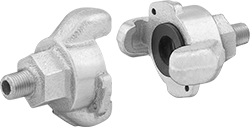How to Identify and Measure Fittings
Pipe size is an industry designation, not the actual size. View information about how to measure threaded and unthreaded pipe and pipe fittings.
More
Twist-Claw Hose Couplings for Air and Water

Also known as Chicago and universal couplings, these have an identical claw-style head that allows you to connect to another Chicago twist-claw hose coupling, regardless of the pipe size or barbed hose ID. To connect, push two couplings together with a quarter twist. Couplings have a safety clip and lanyard to prevent accidental disconnection.
Wye couplings are also known as three-way hose couplings. Use them to connect one inlet to two outlets.
Iron couplings are stronger and more durable than other metal couplings. Use in noncorrosive environments. Warning: There is no valve in these couplings. Stop the flow of air and water before you disconnect the line.


























